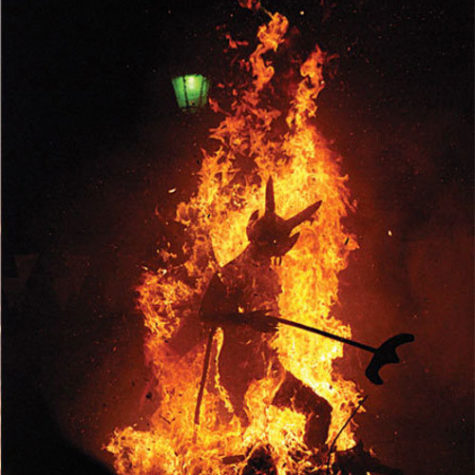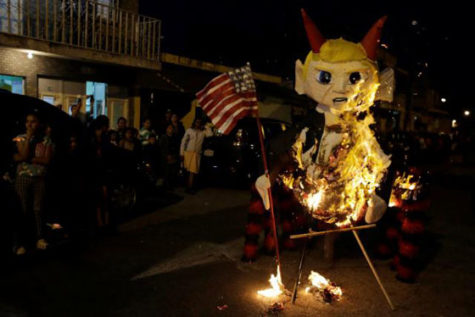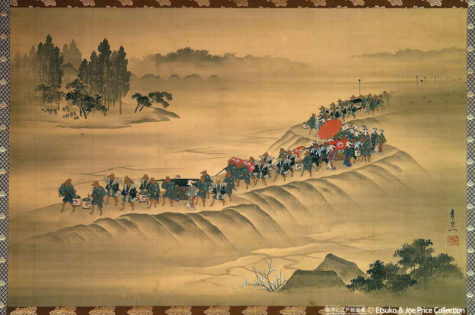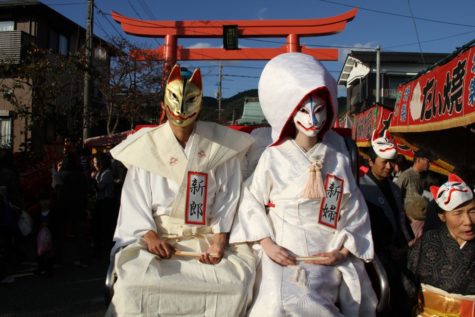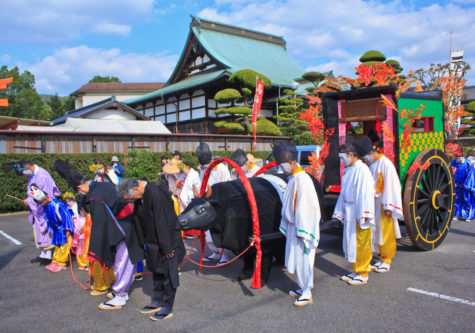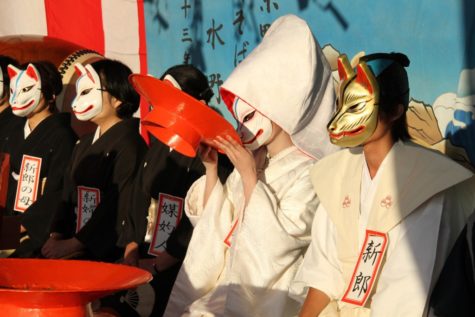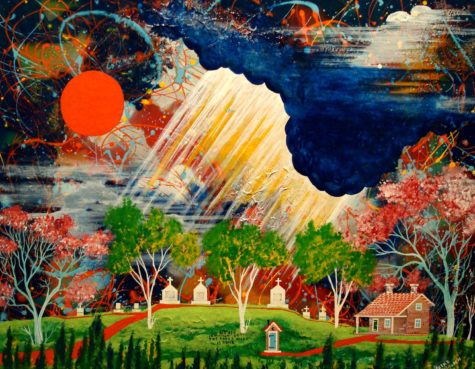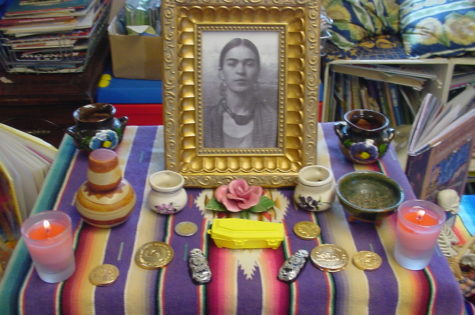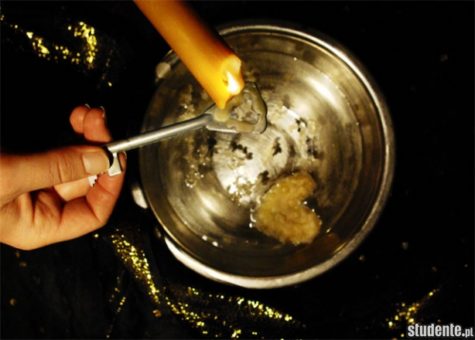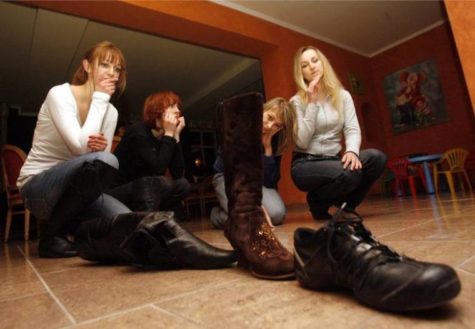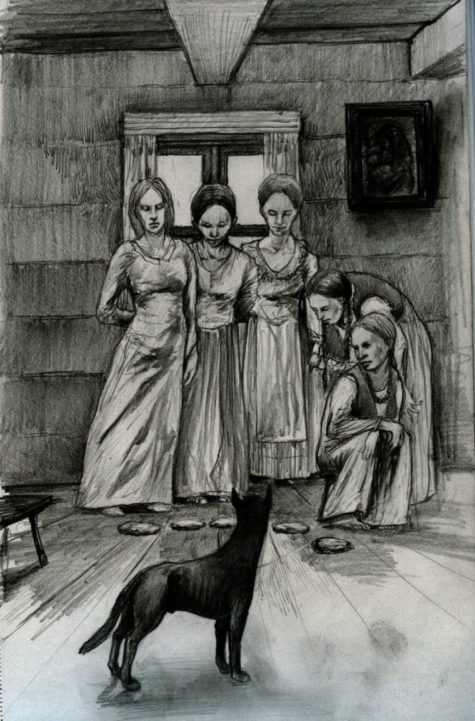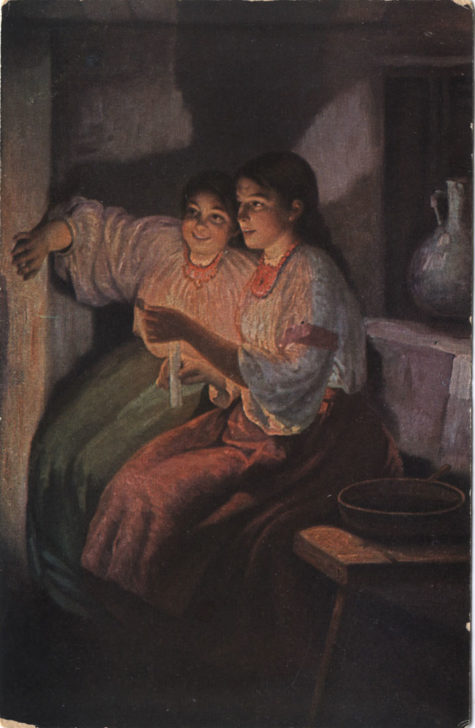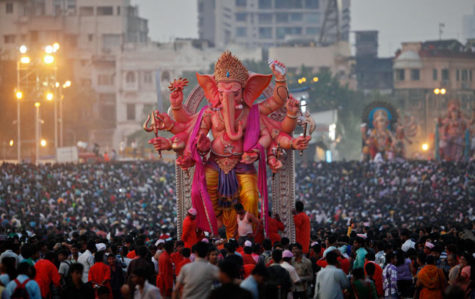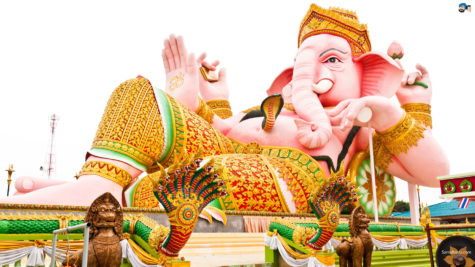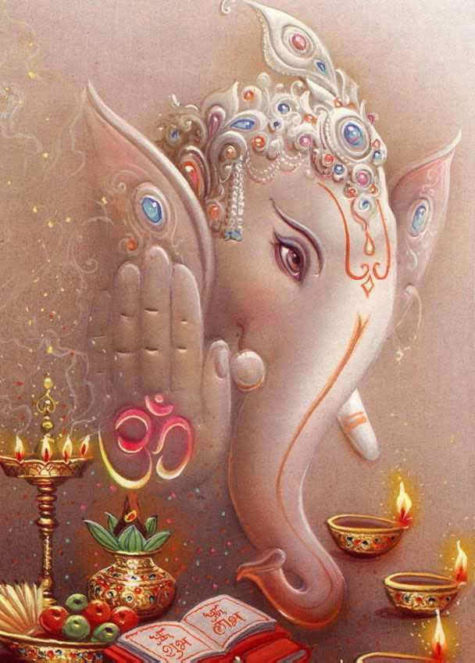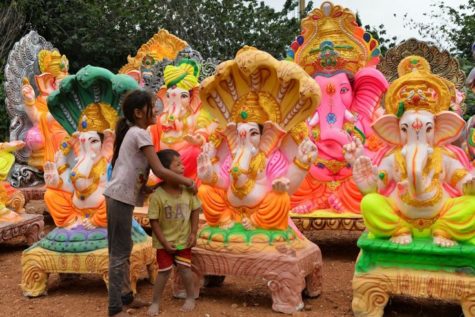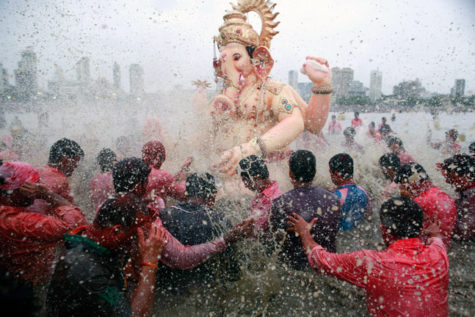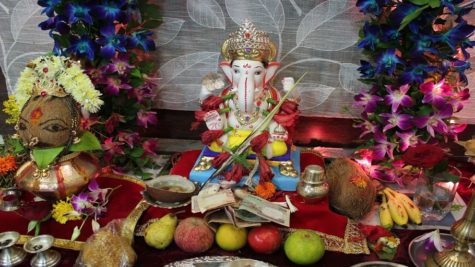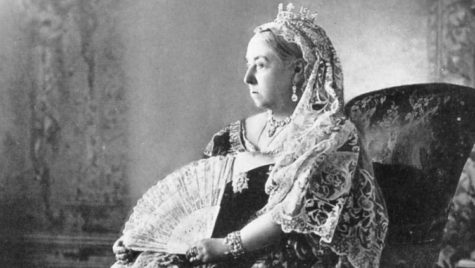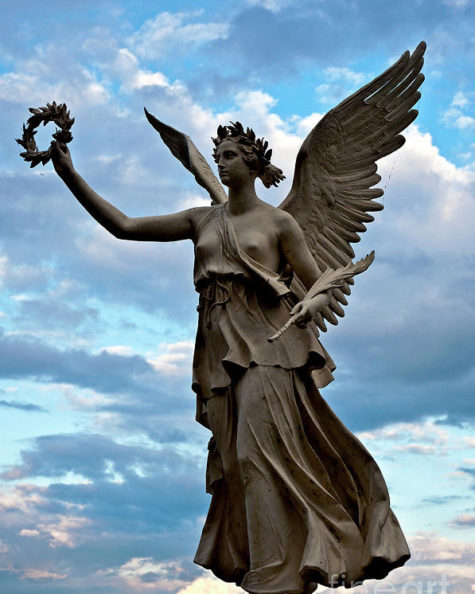Burning the Devil or La Quema del Diablo is a tradition held every December 7, at 6:00 in the evening sharp, families build bonfires outside their homes and burn effigy of Satan. It is a tradition that many Guatemalans take part as a way to cleanse their home from devils that lurk in their home, creeping behind the furniture or hiding under the bed.
La quema del diablo can be traced to colonial time, a tradition that started since the 18th century. Held on the eve of the Feast of the Immaculate Conception and as a prelude to holiday season, those who could afford it adorns the fronts of their houses with lanterns, but for those who have lesser means builds a bonfires from their trash to celebrate the occasion.
A symbolical tradition with a belief that the fire burns the devil serves as purifying element, as the Virgin Mary was the blessed one to conceive baby Jesus must be free from any form of evil, therefore the event serves as “burning the devil” to clear the way for Mary’s feast.
Though the celebration may sound fun, it is controversial especially for the environmentalist groups. Back in the days, mostly paper were burned for the “cleansing ritual”, but now, piles of rubbish are mostly made of plastic and rubber that causes air pollution.
Over time the tradition evolved, from burning piles of garbage and pieces of furniture to being replaced by the effigy of Satan in a form of piñatas.
The tradition has special significance in Guatemala City because of its anticipation of Feast of the Immaculate Conception, the patron saint of the city. Along the street of Zona 1, the historic city center, many vendors pile the street selling stuffs associated with La Quema del Diablo, from firecrackers to simple and intricate devil piñatas. In different parts of the city, people celebrate and burn their own devil piñatas.
The tradition continues, as the idea is to burn all the bad from the previous year and to start anew from the ashes. It is widely observed throughout the country, The Devil is burned at the stroke of six. In Antigua, the former capital of the country, a devil three stories tall is constructed and burned in the city square.
A variation of this tradition is held in San Antonio Palopo. In this very unique celebration, they carry a statue of Maximón around town with a noose around his neck, they locals then hang Maximón by his neck in front of Catholic church, douse him with gasoline, and set him on fire. This is the local way of showing respect to the Christian god.
Setting people on fire has been a way of ridding the town of evil doers for many centuries. As soon as the Spaniards settled in Guatemala they brought with them the Christian religion. The Christian religion frowned on bloodshed. So instead they burned evil doers alive to kill them. This way they did not shed blood and therefor committed no sin.
Most of the inhabitants still pray to both the Christian and Mayan gods and deities such as Maximón or ancestors. They often ask for healing, wealth, help with love and sexual fertility.
The locals say they pray to both just in case one god does not grant their wishes the other might. This happens with both evangelical and Catholic believers. ( Not all, but the majority) This is kept secret for fear of discrimination from others.
While the many of the locals pray to both god and deities they publicly denounce Maximón shortly before Christmas by dragging him around the village then hang him with a noose and set him on fire.
The political version of this festival:
Guatemalans burn traditional devil puppets to start their Christmas celebrations. The ceremonial burning of devils started in the 16th century and is meant to chase away bad spirits. And in 2016, US president-elect Donald Trump was a big hit. But not in a good way.
Revelers in Guatemala set ablaze cardboard piñata of Trump wearing devil horns. In fact, piñata makers said Trump is far and away the best-seller. Trump’s hardline stance on immigration during his election campaign, including a promise to build a wall along the US-Mexico border, has drawn anger from Latin Americans in the US and around the world.
So this is a way to vent out the anger? It can be. Guatemalans believe the practice of torching the devil helps banish bad spirits from their homes and neighborhoods.
Sources:
Most stories advise against seeing a fox wedding—foxes are powerful in Japanese folklore, but dangerous. A wise person keeps well away, and getting wrapped up in Kitsune magick is rarely healthy in Japanese folklore.
If you remain undeterred, and really want to see a Fox Wedding, according to the folklore of the Fukushima Prefecture, it can be done, but only on the 10th day of the 10th month of the Lunar Calendar. (In 2019, this falls on November 6).
- Here’s what to do:
Wear a suribachi mortar on your head and stick the wooden pestle in your belt. Then stand under a date tree. The length of time is unspecified… I’m assuming for however long it takes.
Aichi prefecture has a much easier method—just spit in a well and weave your fingers together. You are said to be able to view the Kitsune no Yomeiri though the gaps in your fingers.
More about the Fox Spirits known as Kitsune can be found at The Powers That Be, a story about a fox wedding can be found on Widdershins. A Fox Wedding festival is held annually in Japan on November 3rd. You can read about that in The Pagan Calendar.
Source: Hyakumonogatari Kaidankai
Many towns hold Kitsune no Yomeiri festivals re-creating the famous processions. Most of these festivals are modern—coming from the 1950s to as recently as the 1990s—and were started as tourist attractions to draw people into town. Local politicians and businesses participate in the festival, and sometimes the fox bride and groom are selected as a sort of “beauty pageant.”
Not all are modern tourist traps, however. The festival in Kudamatsu city, Yamaguchi prefecture, has also been held since ancient times, although it bears little relationship to popular images of the Kitsune no Yomeiri. It involves asking the blessing of a pair of white fox deities whose wedding ceremony is re-enacted every year.
Kitsune no Yomeiri has been an event and Shinto ritual at Inaho Festival since 1950. People who wear fox masks walk at the old street slowly to the final destination – Hanaoka station.
Fox bride and groom ride on a Jinrikisha (a pulled rickshaw), and relatives and attendants dressed in the crested kimono – hakama follow and walk after a Jinrikisha. A Jinrikisha is a two-wheeled vehicle which is pulled and run by a rickshaw driver. It had been used widely in Japan before an automobile was invented.
After fox couple’s arriving at the Hanaoka station, the ceremony called “San San Ku Do” (three-three-nine times) exchange of nuptial (marriage) cups takes place.
What is “San San Ku Do”?
“San San Ku Do” is a ceremony between bride and groom, where they sip sake three times from three sake cups. The sizes of three cups are different. One is a small cup, another is a medium cup, and the other is a large cup.
- Small cup stands for the past.
Drinking from a small sake cup intends to express thanks to ancestors who gave the chance for a couple to meet.
- Medium size cup means the present time.
Drinking from this one stands for the intention of the couple to live together for a long time and helping each other.
- Large size cup means future.
By drinking from a large cup, the couple hopes that both families will be happy in the future with prosperity of both families’ descendants.
The public never knows who play the roles of foxes’ bride and groom. According to a legend, it is said that a person who became a fox bride will find a good partner to get married.
Why Do People Worship Foxes Here?
According to a legend, there was a chief priest in Hory-ji temple. He was known as the person who had high virtues and was loved by people.
One day, he went out, and the on the way back to his temple, he noticed that his rosary (praying beads) was missing. He tried to look for his praying beads, but he could not find it in the dark. He could not do anything and slept in his bed.
When he was sleeping, a white fox appeared in his dream. The fox said to him:
“We are a couple of white foxes who were dead in woods, we will bring your praying beads back to you this evening, if you take our corpses back to your temple and bury us in the same way as human beings. We also promise you to protect the people of your temple and village from misfortune”.
The priest woke up soon.
Surprisingly, there was the rosary he lost by the pillow. After that, the priest found corpses of white foxes, and buried carefully. Since then, people who are looking for something, or who lost something, have been coming to pray here. And actually many of them found what they were looking for.
Sources:
When we consider the month of October and Halloween, our modern take on the Holiday is largely fun and commercially driven, celebrated with spooky costumes and all our favorite Halloween treats. However, this time of year wasn’t always celebrated with ‘trick-or-treating’. Instead, many cultures focus on the celebrations honoring those that came before us.
As we head into the Halloween season, the veil that exists between our world and that of the spiritual will has started to thin out. On Halloween night, also known as All Hallows Eve, it is said that this veil drops, allowing those in the spiritual world to move freely among us. Now, this may sound concerning, to say the least, but don’t get too worried yet. Much like us here on in this life, the spiritual world is filled with both good and not so good spirits. While there are sure to be some mischievous beings trying to bring mischief and chaos into our lives, it is believed that we will also be visited by our deceased loved ones.
The concept of the dead moving among us is the underlying concept behind the Day of the Dead or Dia de los Muertos. Often known as a holiday celebrated in Mexico, records show that these traditions can be dated back as far as the Aztecs. Spanning two days, the holiday specifically focuses on honoring our deceased loved ones, through the use of parties, parades, feasts and other celebrations. Many who celebrate also done colorful costumes and skull makeup, also known as sugar skulls, a symbol that has come to be highly recognizable in today’s pop culture.
All Saints’ Day and All Souls’ Day are also similar to Day of the Dead. These are celebrations embraced by Western Christianity, in which the souls of faithful Christians who have paced are honored with the placing of flowers or candles at their grave sites, and church services discussing their memory. During this time, Christians also pay tribute to the martyrs and saints.
Also known as ‘Summers End’, Samhain is the Pagan holiday celebrated at this time. While this holiday is largely associated with the celebrations of the ancient Celts, many Pagans, Wiccans and Druids will celebrate Samhain around the globe. The holiday marks the end of the harvest season and beginning of winter, however, it also includes a number of celebrations including bonfires and feasts, honoring those that came before them.
Are You Looking For Ways To Honor Your Deceased Loved Ones During This Time? Here Are A Few Ideas:
- Cook a specific meal in honor of your deceased loved one. This is a regular part of the celebrations of Day of the Dead. Those who celebrate would cook the favorite meal of their loved one to ‘share’ in celebration of their time together.
- Use meditation to allow you to open your mind and your heart to communication from your loved ones. Remember, they are moving among you and may very well be trying to let you know that they are there.
- If you do still visit the grave site of a loved one, take some time out this night to be there. Place a lit candle, a flower of your choice or some other memento to show you were there. If you feel their presence, speak aloud to them. Remember, they are moving among us.
- Light a black candle, paying tribute to the stages of life and the inevitable darkness that comes with its final stage, death. Candles are also often used as a tribute or memorial to those who have come before us. If you wish, you can carve the name of your loved one into a taper candle and burn it in honor of a specific loved one.
- Gather friends and family together and light a large bonfire. Share your favorite stories of your friends and loved ones as you feel them moving among you. You can also include their favorite food and drinks in the evening’s celebrations.
- Choose to celebrate life by giving thanks for the life you were given, and that of the family members that came before you. Make a list of all the reasons you have to be appreciative at this time.
- Set up an altar to honor the specific loved ones that hold a special place in your heart. This may include photos or objects that hold a special meaning of some form.
- Take part in an activity that meant something to a friend or loved one that you are choosing to honor. For example, if you recently lost your brother and he was highly into superhero movies, you could enjoy a movie marathon night either on your own or with other loved ones who knew him.
Source: Awareness Act
October 22nd is sacred to all deities of the Crossroads eg Hecate, Legba or Ellegua, Lady Elen, Herne and the Queen of Fairie.
Crossroads have always been seen as magical places. They are places where you have a choice, you can change your destination and take an alternative route. They are places where you might meet strangers or uncanny creatures.
At one time Witches and suicides were buried at crossroads, to confuse their spirits and prevent them haunting. And for the same reason public gallows were often put at a crossroads.
Crossroads are where we can sit and observe magical creatures, the fairies, the Wild Hunt, Witches flying to their meetings. Where spells are more potent and offerings can be left for the gods. And it is the place where we can make a commitment to the Old Path of Witchcraft ourselves.
More about crossroads and magick can be found here: Why Crossroads Are Magickal
Source: Raven Corvus
This is a feast celebrated on the night of 29th/30th November. It’s believed to be a magical night suitable for the love spells, and was celebrated throughout the centuries mostly by the unmarried people who wanted to reveal their future husband or wife.
Similar feasts are also observed for example in some parts of Ukraine, Slovakia, Russia, Germany, Austria and Romania.
A Bit of History
The original name of these celebrations was lost in history. The oldest historical sources confirm that this kind of custom was an old tradition in Poland already around 14th-15th centuries. Information about Polish women who were sentenced to death for conducting wax divinations (described below) can be found in 16th-century documents.
Nowadays the Poles celebrate primarily the Andrzejki (St.Andrew’s Eve), but some remnants of a similar feast of Katarzynki also survived – it was celebrated on the Eve of St. Catherine / Katarzyna (24th/25th Nov), and survived the longest in the region of Biskupin.
It is said that Andrzejki was dedicated primarily to the girls who wanted to know more about their future partner, and Katarzynki was the best for the boys to make divinations.
The Divinations
The most popular form of divination in Poland is pouring hot wax onto cold water. The wax is first melted over fire in a small mug, and then poured through a keyhole. People wait until it hardens properly in the cold water, then the pieces of wax are held against a candle to produce shadow on a wall. Its shapes symbolize things that will happen in the upcoming year.
Instead of a key, in the old days people were using for example woven straw or a horseshoe. People who find it impossible to get a proper key sometimes cut a shape of a key out of hard cardboard. In the past many people used melted lead instead of the wax for the divination.
Other popular divinations include a race of shoes. People gathered in the room take off one of their shoes and everyone places them in one line on the floor. The last shoe in the line is carried to the front – the process is repeated until one of the shoes reaches the front door and crosses the theshold.
Originally it symbolized a girl leaving her home, and owner of the lucky shoe who ‘went out’ (crossed the treshold) first was believed to become the first from the group to get married in the future.
The shoe race can be sometimes manipulated by tilting of the line.
Some old divinations also involve the house pets – cats or dogs. Each person prepares a small bowl with treats – for example milk for a cat or pieces of meat for a dog – and then places it on the floor. Owner of the bowl from which the pet eats first was believed to become the first to get married or find their true love (it depended on the intentions of the divination).
In the old days the treats were prepared very carefully – they were for example small cakes made of certain ingredients, mixed with water that was gathered in a certain way from a well or a brook (brought home for example only in a red mug or only in your own mouth), and baked over fire that was ignited with a wood plank borrowed (or stolen) from a neighbor.
If the pet runs away out of the room with the treat, it was also a good sign meaning a marriage (symbolic crossing of the threshold). However, if the animal hides under a bed with the treat, it meant death of the food’s owner. If the food is only bitten and left in the bowl or close to it, it meant that the partner would break up.
Other popular divination rituals require preparing of pieces of paper with names of the crushes written on it. In one of the versions the paper (preferably in a shape of a heart) is then turned around and pierced with a pin to reveal which of the names is the future spouse. The paper can be also pinned to a wall and serve as a dartboard.
In another version, much older, the people prepare small strips of paper, in a form of lots, and put them under the pillow – they draw one in the morning right after waking up.
Regardless of the version, the papers should always have at least one empty spot / one empty lot in case neither of the chosen names is the destined one.
Before another popular game of divination the people prepare mugs, flipped upside-down, and hide a symbolic accessory under each of them. The mugs are shifted around, and a person (with their eyes covered) chooses one. The hidden accessory indicates the future. It could be for example a ring or a female cap meaning marriage; a twig of rue or a dry leaf meaning spinsterhood / bachelorhood; a rosary, its beads, or a cross meaning a religious life or even life in a monastery; a coin meaning a wealthy life (but not necessarily full of love); a doll meaning an illegitimate child. One mug should be always empty – it means that nothing will change in the nearest future.
Marriage divination has dozens of regional types in Poland, and often take forms of various games or competitions. Many customs are sadly forgotten or not practiced anymore, only being told in stories by the oldest generations.
In the modern days the people treat Andrzejki as a special night that strengthens and ensures effectiveness of various divinations – many of modern activities come also in forms that are known worldwide, for example reading cards or tea leaves. Among most of the modern Polish society the divinations are no longer taken seriously, and are only an occasion for a unique once-in-a-year party, very often combined with celebrations of Andrzej’s namesday.
Source: Lamus Dworski
The following recipe will make approximately 20 lime-sized modakas, a treat for the children, and a traditional offering to Lord Ganesha. It takes about two hours to make them.
Ingredients and Utensils:
- 1 lb rice flour
- 2 cups jaggery (or 2 cups brown sugar with 4 tbsp dark molasses added)
- 2 cups raw sesame seeds
- 2 grated coconuts (optional)
- 2 cups melted ghee (melted butter will also work)
- 1 tsp salt
- Banana leaf or waxed paper
- A flour sifter or fine sieve
- An iddli or vegetable steamer
Directions:
Roast the sesame seeds in a pan, without oil, until golden brown (5 to 10 minutes). Crack the seeds by rolling with a rolling pin or pounding. Add 4 tbsp ghee to the jaggery to soften it, and then mix in the sesame seeds and coconut thoroughly. (This mix may be refrigerated in jars for making quick sweets simply by adding a bit of ghee and shaping the dough into balls).
Next sift the rice flour and toast it without oil until it browns slightly – about 5 to 7 minutes. Spread it out on a tray or table top when done, and allow cooling completely.
While the rice flour is cooling, bring approximately a half-gallon of water, with a tsp of salt, to a rolling boil. Put the cooled, toasted rice flour in a bow. And make a well in the middle. Slowly pour a small amount of the hot water into the well and begin working it into the rice flour with your hands.
Keep adding small amounts of the hot water, and work the flour into a ball of dough. It should be moist but not wet when you put it out on the table or breadboard. Knead the dough thoroughly so it is even in moisture and texture.
Next, place water in the bottom of the steamer and bring to a full boil. Spread a thin coating of ghee or oil on a piece of banana leaf or waxed paper. Take a lump of dough half the size of a lime and work it in your hands for a moment to remove the air and then pat it out flat and round on the leaf, about as wide across as your palm. Make it a uniform thickness so it will cook evenly.
Place a lump of the sesame-jaggery-coconut mixture into the center and wrap the dough up around the mixture. Pinch the dough into a cone-shape over the stuffing and wrap the leaf or paper up around it. (The modakas can also be round if desired.) Repeat until you have enough to fill your steamer.
Place the assembled modakas in the steamer, spaced so as to not touch one another. Cover and steam until done (15 to 20 minutes). While they cook you can prepare the next batch. When cool enough to handle, dip the modakas in melted ghee. Now they are ready to offer.
from Loving Ganesa
by Satguru Sivaya Subramuniyaswam
Vinayaka Chaturthi – also known as Ganesh Chaturthi – is a Hindu holiday festival that is observed on on the fourth waxing moon day during the month of Bhadrapada. This is around August or September on the Gregorian Calendar. The purpose of this festival is to honor the very popular Hindu God Ganesha, also known as Vinayaka.
- Dates vary from year to year.
- In 2018, the festival runs from September 12 thru Sept 23.
The concept of Ganesh Chaturthi is that Ganesha comes to the home of his devotees on Ganesh Chaturthi day. He brings auspiciousness, hope, success and happiness to all homes. During His brief stay, He removes all obstacles. While returning He takes with him all problems and unhappiness.
Vinayaka Chaturthi is a festival that allows people to call on the power of Ganesh and to receive help from him in removing all of the obstacles that hinder their spiritual or mental path. It is also a time to ask for help in developing spiritual strength and resolve. It is a festival of great hope, joy and celebration that can be enjoyed by everyone regardless of class or wealth.
This remains one of the most widely celebrated festivals in the Country, partly because Ganesh is one of the most popular deities for worship. Ganesha, the elephant-headed son of Shiva and Parvati, is the supreme god of knowledge, wisdom, prosperity and good fortune. He is the Lord who is first worshiped before any holy occasion or puja.
His blessings are often invoked at religious ceremonies as he is the one who can remove all obstacles to success, particularly when people are starting a new business or enterprise. Ganesh is known as the giver of fortune and one who can help to avoid natural calamities. Ganesh is also the patron god of travelling.
Lord Vinayaka is revered as the preserver of all good things and prevents Vigna (meaning obstruction/bad omen). His motto is Shubh-Laabh (good prospect and good prosperity).
The Significance of the Festival
Hindus believe that during Ganesh Chaturthi, Lord Ganesh visits his people on the earth to personally attend to their prayers. Therefore the divine energy of Lord Ganesh descends on the earth in large measures during the event. The idols of Ganesh newly bought and installed act as antennas to receive the energies of Lord Ganesh and transfer them to the people during worship. After the worship, this is why the idols specially installed for the puja are immersed marking the sendoff.
How the Ganesh Chaturthi is celebrated:
Ganesh Chaturthi is celebrated with great devotion all over India. People bring home murtis (Idols) of Lord Ganesha and celebrate the festival by worshiping the Lord in a special way for a day and a half, 3 days, 5 days, 7 days or 11 days depending on the family tradition and commitment of each individual.
In certain parts of India, such as Andhra Pradesh and Maharashtra, the festival is celebrated for ten days and is a very public occasion. Elsewhere it may celebrated in homes, where hymns are sung and offerings made to Ganesh. Sweets are a common offering as Hindu legend has it that Ganesh liked them. On the last day of worship the idol is taken out in a colorful and musical procession to be immersed traditionally at a beach.
Rituals during the festival include:
- Pranapratishhtha – the process of infusing the deity into a murti or idol.
Several months before the start of Vinayaka Chaturthi, a large clay statue of Ganesha is crafted. There is no set size limit for this murti, it can be smaller than an inch or be over twenty feet tall, depending on the person making it. This murti is then either placed in homes or set up in specially made tents so that people can pay respect to it.
If you are interested in making one of your own, here’s a link to a short simple tutorial on how to make one out of paper mache. Some artistic ability is helpful but not required. Make A Paper Mache Ganesh
Ganesh Chaturthi starts with the installation of these Ganesh statues in colorfully decorated homes and specially erected temporary structures mantapas (pandals or colorful temporary shrines) in every locality. The mantapas are decorated specially for the festival, either by using decorative items like flower garlands, small banana saplings, lights, etc or are theme based decorations, which depict religious themes or current events.
The statues are worshiped with families and friends. The priest, usually clad in red silk dhoti and shawl, then invokes life into the statue amidst the chanting of mantras. This ritual, also known as Pranapratishhtha, is done to breathe life into the idol.
- Shhodashopachara – 16 forms of paying tribute to Ganesha.
After life is breathed into the image of Ganesh, people pay respect to the murti by offering it all kinds of different items. The offerings include 21 durva (trefoil) blades of grass, red flowers, coconut, jaggery, 21 modakas. The statue is anointed with Kumkum and Sandalwood paste. Vedic hymns from the Rig Veda, the Ganapati Atharva Shirsha Upanishad, and the Ganesha stotra from the Narada Purana are chanted.
For the next ten days, the statue is worshiped.
- Uttar Puja – saying farewell before the murti is moved.
Uttar Puja is performed in order to provide a farewell to Lord Ganesh just before the immersion. Here is the step by step procedure of Uttar Puja.
Light a lamp near the idol and decorate the idol with flowers. The puja will consist of offering Achamaniyam (water to drink), Sankalp (determination), chandanarpan (sandal paste), pushpa puja (puja with flowers), Durvarpan (offering durva grass), dhopp and deep darshan (offering incense and camphor light), Nivedan (offering some dishes and fruits). Say the prayers, chant Ganesh mantras and then do arati. Then do namaskar and move the idol a little with your right hand to mark the conclusion of uttar puja.
- Ganpati Visarjan – immersion of the idol in the river.
On the eleventh day, after the Uttar puja, the Ganesh idols are taken in procession with a huge fanfare to the water bodies. The crowds shout the names of Ganesh in ecstasy and make the procession a colorful and vibrant event. The idols taken in the procession are of different sizes, models and colors. They are carried through the streets for all to see. When this has concluded, people once again pay homage one last time before they are taken to the river and submersed.
The divine energies in the idols are transferred to the waters and then to the larger world. Therefore through the process of Visarjan, three objectives of the devotees are fulfilled namely saying thanks to Ganesh for the favors received, giving a sendoff to the Lord and sending the divine powers of the Lord for the benefit of all.
The idols are immersed one by one in the waters either manually or with the help of a crane. Usually, curd rice or puffed rice is made a bundle and sent along with the idol as a mark of giving food for the deity to have while journeying. After the visarjan, some sand is collected from the spot and sprinkled around the home.
- Alternatively:
Many of the Ganesh idols will be placed outside under Bodhi Trees (Sacred Fig). The Bodhi tree is revered as a great source of remedies and is used to treat up to 50 different ailments. It also has a unique ability in that it can produce Oxygen at night-time instead of Carbon Dioxide. These healthy aspects of the tree make it a popular place for people to go to worship, as it is seen a great healer to naturally cure illnesses.
Performing A Puja At Home:
Every Hindu puja starts with the invocation of God in the object of worship in order to accept the puja and prayers. After the puja, there is a ritual called ‘Yathasthan’ meaning giving a sendoff to the deity worshiped. This is the spirit and logic behind Ganesh Visarjan also. Spiritually, this process prepares a man to move from the form to the formless state of God.
Here are the things which you will need for Ganesh Chaturthi Puja.
- An idol of Lord Ganesh.
- Chandan or sandalwood paste.
- Red flowers, preferably Hibiscus flowers.
- Incense sticks.
- Durva grass.
- Modakas (here’s a recipe) or any sweet made at home after taking bath and without having any food.
- Some fruits.
- A Chaurang or elevated table to place the idol.
- A cloth to cover the table and things to decorate it like lights.
- Diya to light in front of the idol for Aarti.
Preparation for Ganesh Chaturthi Puja at Home
Sweep and wipe clean your house. Bring the idol of Ganesh at home and you can invite your friends and relatives for the Puja. Let your entire family gather at the time of Puja. Recite Ganesh Shlokas to welcome the Lord in your house.
Many families invite Pandits or Brahmins to do Ganesh Chaturthi Puja at home so that they can perform the Puja of Lord Ganesh the right way. For any Puja or Vrat you need two things – cleanliness and devotion. This will help you get the blessings of Lord Ganesh.
- Clean your house and take bath. Wear fresh clothes and get ready for the puja.
- Prepare the Ganesh mandap with coconut or banana leaves. You can use mango leaves and flowers also to decorate it. Some decorate it with leaves of the Ashoka tree.
- A pot filled with water and rice is installed near the idol of Lord Ganesh.
- Now place the idol of Lord Ganesh saying ‘Om Ganeshay Namah’.
- Start the Puja by chanting 108 names of Lord Ganesh or chant simple Ganesh mantras.
- Light the Diya or lamp and offer Aarti to the Lord by singing hymns especially dedicated to Ganesh or Ganesh Aarti.
- Offer Naivaidya of special recipes and fruits to Ganesh Jee.
There is a significance of number 21 in this Puja and so people offer 21 Durva grass blades and 21 Modaks. 21 signify – 5 organs of perception, 5 organs of action, 5 vital airs, 5 elements and the mind.
However, when you are performing Ganesh Chaturthi Puja at home you can be flexible. All you need to have is clean body and mind and the thing that is most important is devotion and not the ritual. So, try to keep things simple and concentrate on the Puja.
Information collected from various sources
According to some calendars, August 1st is the Egyptian New Year. So if you’d like to rethink those New Year’s Resolutions from back in January, or if you’d like to do some spells or rituals for the New Year but don’t want to wait another four months, today is a golden opportunity.
“Wipe the slate clean
dream a new dream.”
With a little bit of imagination, the above quote can be used to create a spell for new beginnings. Here’s an example. You will need a small chalkboard or dry erase board, or a piece of paper, a pencil, and an appropriate eraser.
Light a white candle and think about the resolutions you made for the New Year, in particular, the ones that you were unable to keep. Write them on the chalkboard. As you write each one, say out loud:
“I don’t have to do this
if I don’t want to!”
Now, take your eraser, and begin erasing the resolutions. As you erase, chant the following incantation over and over until the chalkboard (or whatever you used) is totally clean.
“I wipe the slate clean,
I dream a new dream.”
You now have a clean slate, and an opportunity to create a whole new dream. Enjoy!
Note: This post was put together by Shirleytwofeathers you may repost and share if you give me credit and a link back to this website. Blessed be.
Victoria Day, also known as May Two-Four, May Long, and May Long Weekend, is a Canadian holiday on the Monday preceding May 25. (In 2019, this falls on May 20).
What Do People Do?
In some cities, fireworks displays or parades are held to mark Victoria Day. One of the most notable parades is held in the city of Victoria, British Columbia, which was named after Queen Victoria. Many people gather in parks to enjoy fireworks displays, which are particularly impressive in Hamilton and Toronto.
For many people, the long Victoria Day weekend marks the end of the winter and the unofficial start of the spring or summer season. After this weekend, gardeners can be reasonably sure that there will be no more frost until the autumn so they can sow or plant out delicate crops and plants.
For the same reason, people with recreational homes in colder parts of the country often go to them to open them up for the summer. In addition, many amusement parks and outdoor attractions open for their summer season this weekend. Notably, stores on Prince Edward Island are permitted to open on Sunday only between Victoria Day and Christmas Day.
The History of Victoria Day
Queen Victoria was born on May 24, 1819. Following the death of 3 uncles and her father, she became Queen of the United Kingdom on June 20, 1837 and reigned until her death on January 22, 1901. During Victoria’s life, the British Empire expanded considerably. However, her powers as Queen of the United Kingdom were reduced as the House of Commons became more important and powerful in British politics.
The monarch’s birthday has been celebrated in Canada since before the beginning of Queen Victoria’s reign. After her death, in 1901, May 25 became known as Empire Day. The sovereign’s official birthday was still celebrated, often on the King’s or Queen’s actual birthday. In 1952, Empire Day was moved to the Monday before May 25 and since 1953, the official birthday of Queen Elizabeth II has been celebrated on this date in Canada. In 1958, Empire Day became known as Commonwealth Day, which was moved to the second Monday in March. The Monday before May 25 then became known as Victoria Day, which is a Canadian statutory holiday.
From 365 Goddess
- Themes: Victory; Success; Excellence
- Symbols: Wings (or feathers); Laurel
- Presiding Goddess: Victoria
About Victoria:
Victoria, as her name implies is the Roman goddess of attainment. Early in the year she inspires resolve within us to do everything we undertake, with excellence as a goal. In works of art, Victoria is often depicted with wings that allow her to surmount any obstacle or problem.
To Do Today:
Drink a tea made from lemon balm, ginger, and a pinch of cinnamon to generate a successful attitude. Remember, if you think you can, you can!
Put a bay leaf (a form of laurel) in your shoe so that Victoria’s triumphant energy can walk with you all day long. Later in the day, burn a few bay leaves on a fire source to fill your home with success. Alternative aromas that invoke Victoria’s favor are rose and red sandalwood.
To make a victory charm, find a feather (or cut paper in the shape of a feather) and empower it with this incantation:
With the wings of Victoria, I will rise
above all areas where trouble lies
Through diligence and mastery I will see
today begins my victory!
Carry this token anytime you feel your confidence waning, or when you need a boost to get over any seemingly insurmountable obstacle.
Sources:
